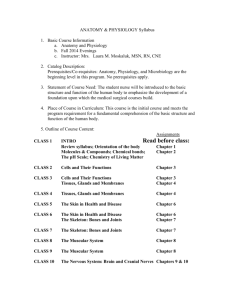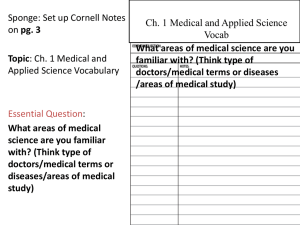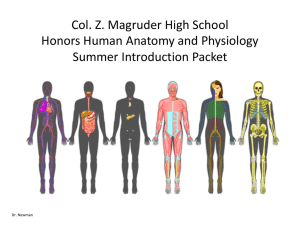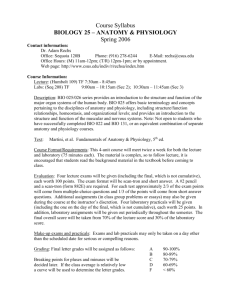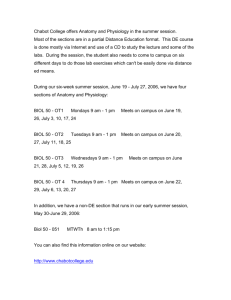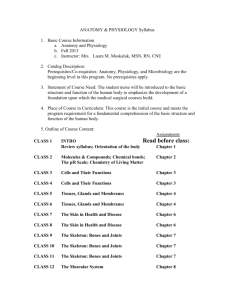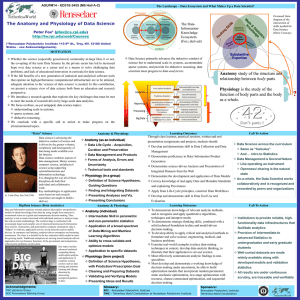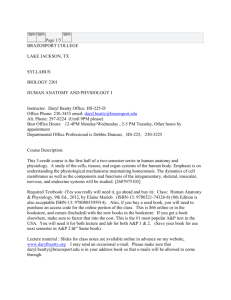PowerPoint Lecture Outlines to accompany Hole*s Human Anatomy
advertisement
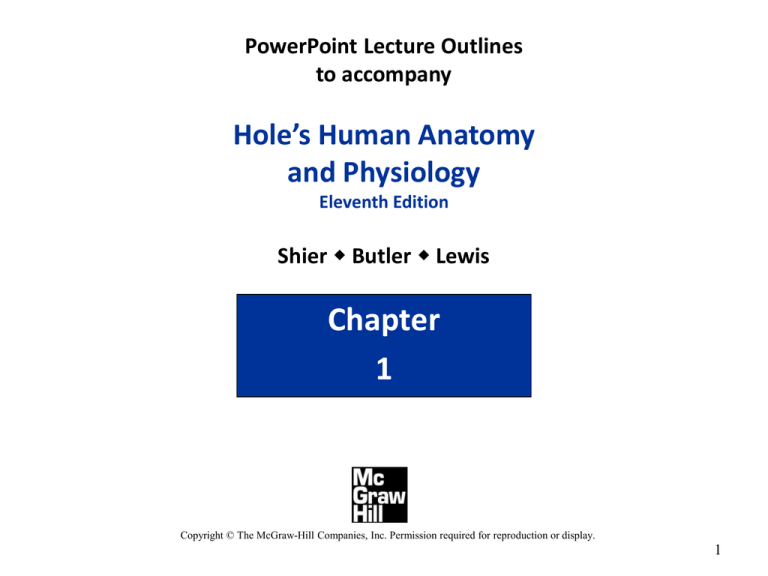
PowerPoint Lecture Outlines to accompany Hole’s Human Anatomy and Physiology Eleventh Edition Shier w Butler w Lewis Chapter 1 Copyright © The McGraw-Hill Companies, Inc. Permission required for reproduction or display. 1 Chapter 1 Introduction to Human Anatomy and Physiology 2 Some Medical and Applied Science Vocabulary • • • • • • • • • • • • Cardiology Dermatology Endocrinology Gastroenterology Geriatrics Gerontology Gynecology Hematology Histology Immunology Neonatology Nephrology • • • • • • • • • • • • • • Neurology Obstetrics Oncology Ophthalmology Orthopedics Otolaryngology Pathology Pediatrics Pharmacology Podiatry Psychiatry Radiology Toxicology Urology Cardiology- Branch of medical science dealing with the heart and heart diseases Dermatology- Study of skin and its diseases Endocrinology- Study of hormones, hormonesecreting glands, and associated diseases Gastroenterology- Study of the stomach and intestines, as well as their diseases Geriatrics- Branch of medicine dealing with older individuals and their medical problems Gerontology- Study of the process of aging and the various problems of older individuals Gynecology- Study of the female reproductive system and its diseases Hematology- Study of blood and blood diseases Histology- Study of the structure and function of tissues Immunology- Study of the body’s resistance to disease Neonatology- Study of newborns and the treatment of their diseases Nephrology-Study of the structure, function, and diseases of the kidneys Neurology-Study of the nervous system in health and disease Obstetrics- Branch of medicine dealing with pregnancy and childbirth Oncology- Study of cancers Ophthalmology- Study of the eye and eye diseases Orthopedics- Branch of medicine dealing with the muscular and skeletal systems and their problems Otolaryngology- Study of the ear, throat, larynx, and their diseases Pathology- Study of the structural and functional changes within the body associated with disease Pediatrics- Branch of medicine dealing with children and their diseases Pharmacology- Study of drugs and their uses in the treatment of diseases Podiatry- Study of the care and treatment of the feet Psychiatry- Branch of medicine dealing with the mind and its disorders Radiology- Study of X rays and radioactive substances, as well as their uses in diagnosing and treating diseases Toxicology- Study of poisonous substances and their effects of physiology Urology- Branch of medicine dealing with the urinary and male reproductive systems and their diseases Car Accident Reading • Read story • Underline key points/phrases/main ideas/important info • Circle vocabulary or unknown words Discussion Questions • What are vital signs? Name at least 3. • What are hematomas? Explain what they look like. • What might a hematoma indicate? • Why is it important to know a patients previous medical history when treating them? • How can listening to our internal organs help us identify if something is wrong? 1) Answer group discussion questions on pg. 11 of your interactive notebook • What are vital signs? Name at least 3. • What are hematomas? Explain what they look like. • What might a hematoma indicate? • Why is it important to know a patients previous medical history when treating them? • How can listening to our internal organs help us identify if something is wrong? 2) Share and discuss the answers to the 3 questions on the History of Anatomy reading- rewrite them on pg. 11 if you didn’t have room on your reading page 11 Homework • Read the History of Anatomy • Underline main ideas/important information • Circle vocabulary or unknown words • Answer the 3 questions on the bottom on the bottom of Pg. 10 in your interactive notebook Hippocrates: Hippocratic oath “Hippa” Sponge: Set up Cornell Notes on pg. 13 Topic: Ch. 1 Anatomy and Physiology and Levels of Organization Essential Question: Explain the levels of organization of the human body Don’t forget to add it to your T.O.Contents! 1 Anatomy 2.1Ch. Atoms, Ions, and Physiology and and Molecules Levels of Organization Explain the levels of organization of the human body The 2 major areas of medical science are: Anatomy and Physiology Anatomy – study of the structures of body parts: their forms and organization (Greek – “cutting up”) 16 Physiology – study of the functions or jobs of the body parts-what they do and how they do it (Greek – “relationship to nature”) 17 Think of different parts of your body, or of another animal’s body: How do their structures relate to their functions? Exs: Hand/fingers= to grasp, grab, or hold objects Teeth= to grind up food so we can swallow them Pelican’s bill= to scoop up fish from the sea for eating 18 *Structure is always related to function 19




